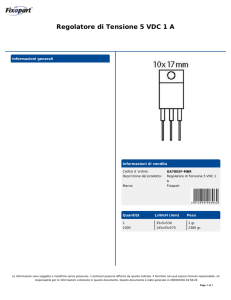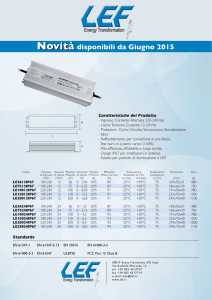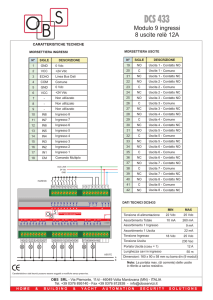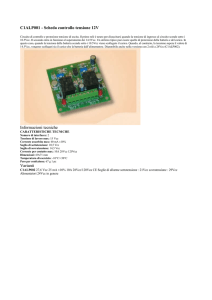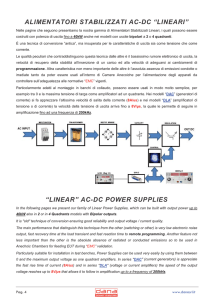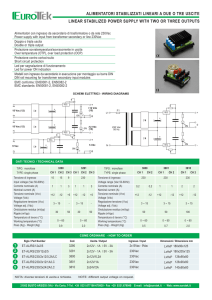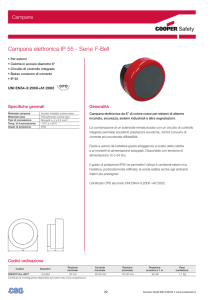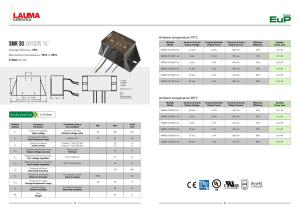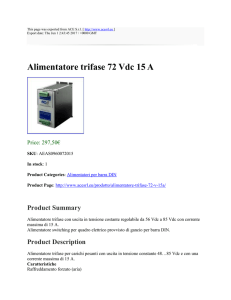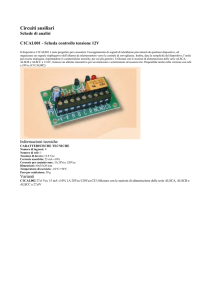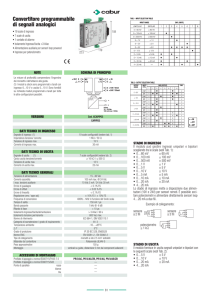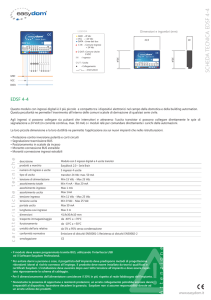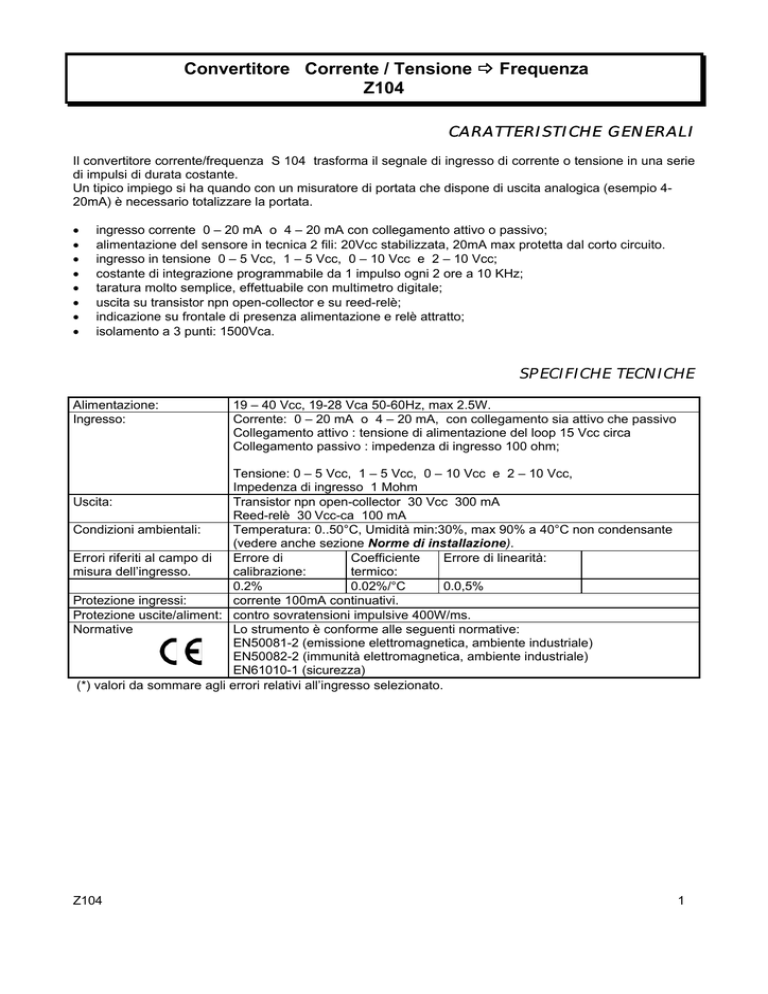
Convertitore Corrente / Tensione _ Frequenza
Z104
CARATTERISTICHE GENERALI
Il convertitore corrente/frequenza S 104 trasforma il segnale di ingresso di corrente o tensione in una serie
di impulsi di durata costante.
Un tipico impiego si ha quando con un misuratore di portata che dispone di uscita analogica (esempio 420mA) è necessario totalizzare la portata.
•
•
•
•
•
•
•
•
ingresso corrente 0 – 20 mA o 4 – 20 mA con collegamento attivo o passivo;
alimentazione del sensore in tecnica 2 fili: 20Vcc stabilizzata, 20mA max protetta dal corto circuito.
ingresso in tensione 0 – 5 Vcc, 1 – 5 Vcc, 0 – 10 Vcc e 2 – 10 Vcc;
costante di integrazione programmabile da 1 impulso ogni 2 ore a 10 KHz;
taratura molto semplice, effettuabile con multimetro digitale;
uscita su transistor npn open-collector e su reed-relè;
indicazione su frontale di presenza alimentazione e relè attratto;
isolamento a 3 punti: 1500Vca.
SPECIFICHE TECNICHE
Alimentazione:
Ingresso:
19 – 40 Vcc, 19-28 Vca 50-60Hz, max 2.5W.
Corrente: 0 – 20 mA o 4 – 20 mA, con collegamento sia attivo che passivo
Collegamento attivo : tensione di alimentazione del loop 15 Vcc circa
Collegamento passivo : impedenza di ingresso 100 ohm;
Tensione: 0 – 5 Vcc, 1 – 5 Vcc, 0 – 10 Vcc e 2 – 10 Vcc,
Impedenza di ingresso 1 Mohm
Uscita:
Transistor npn open-collector 30 Vcc 300 mA
Reed-relè 30 Vcc-ca 100 mA
Condizioni ambientali:
Temperatura: 0..50°C, Umidità min:30%, max 90% a 40°C non condensante
(vedere anche sezione Norme di installazione).
Errori riferiti al campo di
Errore di
Coefficiente
Errore di linearità:
misura dell’ingresso.
calibrazione:
termico:
0.2%
0.02%/°C
0.0,5%
Protezione ingressi:
corrente 100mA continuativi.
Protezione uscite/aliment: contro sovratensioni impulsive 400W/ms.
Normative
Lo strumento è conforme alle seguenti normative:
EN50081-2 (emissione elettromagnetica, ambiente industriale)
EN50082-2 (immunità elettromagnetica, ambiente industriale)
EN61010-1 (sicurezza)
(*) valori da sommare agli errori relativi all’ingresso selezionato.
Z104
1
NORME DI INSTALLAZIONE
Il modulo Z104 è progettato per essere montato su guida DIN 46277, in posizione verticale.
Per un funzionamento ed una durata ottimale, bisogna assicurare una adeguata ventilazione ai moduli,
evitando di posizionare canaline o altri oggetti che occludano le feritoie di ventilazione.
Evitare il montaggio dei moduli sopra ad apparecchiature che generano calore; è consigliabile il montaggio
nella parte bassa del quadro.
CONDIZIONI GRAVOSE DI FUNZIONAMENTO:
Le condizioni di funzionamento gravose sono le seguenti:
• Tensione di alimentazione elevata (> 30Vcc / > 26 Vca)
• Alimentazione del sensore in ingresso.
Quando i moduli sono montati affiancati è possibile che sia necessario separarli di almeno 5 mm nei
seguenti casi:
•
•
Con temperatura del quadro superiore a 45°C e almeno una delle condizioni di funzionamento gravoso
verificata.
Con temperatura del quadro superiore a 35°C e almeno due delle condizioni di funzionamento gravoso
verificata.
D1
D2
D3
D4
D5
D6
PREDISPOSIZIONE DEL SEGNALE DI INGRESSO
Predisporre i DIP-switch contrassegnati con “INGRESSO” come indicato nella tabella seguente:
1
0
Corrente 4 - 20 mA
1
0
Tensione 0 - 5 Vcc
1
0
Tensione 1 - 5 Vcc
1
0
Tensione 0 - 10 Vcc
1
0
Tensione 2 - 10 Vcc
1
0
Posizione di TARATURA
1
0
D1
D2
D3
D4
D5
D6
D1
D2
D3
D4
D5
D6
D1
D2
D3
D4
D5
D6
D1
D2
D3
D4
D5
D6
D1
D2
D3
D4
D5
D6
D1
D2
D3
D4
D5
D6
Corrente 0 - 20 mA
Tabella 1
Z104
2
TARATURA (SOLO PER TECNICI ESPERTI):
LO STRUMENTO VIENE FORNITO - SU RICHIESTA - GIA' TARATO.
E’ possibile tarare lo strumento utilizzando un comune tester digitale con la procedura spiegata di seguito:
Se il numero di impulsi/ora da totalizzare è P , si dovrà scegliere nella tabella seguente la scala che
comprende il numero P, e predisporre i DIP-switch “RANGE”, nella posizione corrispondente data dalla
tabella 2 :
IS
FS
IS
-
1
0
9.000.000 -
2.100.000
1
0
2.250.000 -
530.000
1
0
560.000 -
132.000
1
0
140.000 -
33.000
1
0
35.000 -
8.200
1
0
8.500 -
2.100
1
0
2.150 -
520
1
0
540 -
130
1
0
135 -
32
1
0
33 -
8
1
0
8 -
2
1
0
2 -
0,5
1
0
D1
D2
D3
D4
D5
D6
D1
D2
D3
D4
D5
D6
D1
D2
D3
D4
D5
D6
D1
D2
D3
D4
D5
D6
D1
D2
D3
D4
D5
D6
D1
D2
D3
D4
D5
D6
D1
D2
D3
D4
D5
D6
D1
D2
D3
D4
D5
D6
D1
D2
D3
D4
D5
D6
D1
D2
D3
D4
D5
D6
8.400.000
D1
D2
D3
D4
D5
D6
36.000.000 -
D1
D2
D3
D4
D5
D6
-
D1
D2
D3
D4
D5
D6
FS
Tabella 2
Collegare un tester predisposto sulla portata di 10Vcc ai morsetti 1 ( - ) e 5 ( + ).
Con segnale di ingresso scollegato, spostare i DIP-switch “INGRESSO” nella posizione TARATURA:
Ruotare il trimmer di taratura fino a leggere il valore dato dalla formula:
Tensione da leggere =
in cui:
10 x P x K
-------------FS
P è il numero di impulsi/ora da totalizzare
K è una costante di taratura (riportata sull'etichetta dello strumento)
FS è il fondo scala della scala selezionata in tabella 2.
Al termine della taratura riportare i DIP-switch “INGRESSO” (vedi tabella 1) nella posizione corrispondente
all'uscita del vostro sensore.
Esempio: per totalizzare 90 impulsi / ora, posizionare i DIP-switch “RANGE” (sul pannello superiore) nella
configurazione data dalla tabella 2.
Portate i quattro DIP-switch “INGRESSO” in posizione TARATURA:
Ruotate il trimmer di taratura fino a leggere la tensione:
Tensione da leggere
=
10 x 90 x 1,05
------------------140,625
=
6,72Vcc
Nella formula precedente 1,05 si è supposto sia il fattore K stampato sull’etichetta laterale dello
strumento.
Z104
3
Alla fine riportate i DIP-switch “INGRESSO” (vedi tabella 1) nella posizione corrispondente all'uscita del
vostro sensore.
COLLEGAMENTI ELETTRICI
Si raccomanda l’uso di cavi schermati per il collegamento dei segnali; lo schermo dovrà essere collegato ad
una terra preferenziale per la strumentazione. Inoltre è buona norma evitare di far passare i conduttori nelle
vicinanze di cavi di installazioni di potenza quali inverter, motori, forni ad induzione ecc.
ALIMENTAZIONE
19 ÷ 28 V
19 ÷ 40 V =
La tensione di alimentazione deve essere compresa tra 19 e 40 Vcc (polarità indifferente),
19 e 28 Vca; vedere anche la sezione NORME DI NSTALLAZIONE.
I Iimiti superiori non devono essere superati, pena gravi danni al modulo.
E’ necessario proteggere la sorgente di alimentazione da eventuali guasti del modulo
mediante fusibile opportunamente dimensionato.
1 2 3
INGRESSI
Corrente con
alimentazione
interna del loop
+
Corrente con
alimentazione
esterna del loop
-
4
6
mA
-
mA
+
6
+
Vext
1
Tensione
+
V
-
6
1
USCITE
Reed-relè
30Vcc-ca 100mA
Npn open-collector
30Vcc 300mA
9
12
7
10
+
-
E.S.A.M. unicenter s.r.l.
Elettronica Strumenti Apparecchiature Misura
Z104
L’uscita a reed-relè può essere utilizzata solo con
frequenze inferiori a 40 Hz.
L’uscita a reed-relè si attiva portando in ON il DIPswitch nr. 1 del gruppo “RANGE”.
L’uscita a transistor è sempre attiva.
20010 Bareggio (MI) Italia – Via S. Pietro, 10
Tel. 02.903.61.297 (3 l.r.a.) – fax 02.903.62.314
4
Current / Voltage _ Frequency Converter
Z104
GENERAL FEATURES
The current/frequency converter Z104 transforms the current or voltage input signal into a series of pulses
of constant duration.
A typical use is when, with a flow meter featuring an analogue output (example 4-20mA), the flow must be
totalized.
•
•
•
•
•
•
•
•
current input 0 – 20 mA or 4 – 20 mA with active or passive connection;
supply of the sensor with 2-wire method: 20VDC stabilized, max. 20mA protected against shortcircuiting.
input in voltage 0 – 5 Vdc, 1 – 5 Vdc, 0 – 10 Vdc and 2 – 10 Vdc;
integration constant, programmable in the range 1 pulse every 2 hours to 10 KHz;
straightforward setting, can be performed using a digital multimeter;
output on npn open-collector transistor and on reed-relay;
power ON and relay pick-up indicator on front panel;
3-point insulation: 1500Vac.
TECHNICAL FEATURES
Power supply:
Input:
19 – 40 Vdc, 19-28 Vac 50-60Hz, max 2.5W.
Current: 0 – 20 mA or 4 – 20 mA, both active and passive connection
Active connection : loop supply voltage approx. 15 Vdc
Passive connection : input impedance 100 ohm;
Voltage: 0 – 5 Vdc, 1 – 5 Vdc, 0 – 10 Vdc and 2 – 10 Vdc,
Input impedance 1 Mohm
Output:
Npn open-collector transistor 30 Vdc 300 mA
Reed-relay 30 Vdc-sc 100 mA
Environmental conditions: Temperature: 0..50°C, Humidity min.:30%, max. 90% at 40°C non condensing
(also see section entitled Installation instructions).
Setting error:
Temperature Linearity error:
Errors referred to the
input’s range of
coefficient:
measurement.
0.2%
0.02%/°C
0.0,5%
Input protection:
continuous 100mA current.
Output/supply protection: against impulse overvoltage 400W/ms.
Standards
The instrument conforms to the following standards:
EN50081-2 (electromagnetic emissions, industrial environment)
EN50082-2 (electromagnetic immunity, industrial environment)
EN61010-1 (safety)
(*)values to be added to the errors relating to the input selected.
Z104
5
HOW TO INSTALL
Z104 module is designed to be mounted on a DIN 46277 bar, in vertical position.
To obtain an optimal working and duration, it is necessary to assure an adeguate ventilation to modules,
avoiding to place raceways or other objects that can close abat-vents.
Avoid to mount modules over deviced that generate heat; we suggest to mount devices in the lower side of
the panel.
HEAVY WORKING CONDITIONS:
Heavy working conditions are:
• High power voltage a (> 30Vdc / > 26 Vac)
• Input sensor feeded.
When modules are put side by side it s possible that it is necessary to separate them at least 5 mm in the
following cases:
•
•
Upper board temperature higher than 45°C and at least one of the heavy working conditions verified.
Upper board temperature higher than 35°C and at least two of the heavy working temperature verified.
D1
D2
D3
D4
D5
D6
INPUT SIGNAL SETUP
Set the DIP-switches marked «INPUT» as indicated in the following table:
1
0
Current 4 - 20 mA
1
0
Voltage 0 - 5 Vdc
1
0
Voltage 1 - 5 Vdc
1
0
Voltage 0 - 10 Vdc
1
0
Voltage 2 - 10 Vdc
1
0
SETTING position
1
0
D1
D2
D3
D4
D5
D6
D1
D2
D3
D4
D5
D6
D1
D2
D3
D4
D5
D6
D1
D2
D3
D4
D5
D6
D1
D2
D3
D4
D5
D6
D1
D2
D3
D4
D5
D6
Current 0 - 20 mA
Table 1
Z104
6
SETTING (FOR EXPERT TECHNICAL PERSONNEL ONLY):
THE INSTRUMENT CAN BE SUPPLIED FACTORY SET ON REQUEST.
The instrument can be set using a common digital tester following the procedure explained below:
If the number of pulses/hour to be totalized is P, the scale including the number P must be chosen from the
following table and the «RANGE» DIP-switches set to the corresponding position given in table 2:
Table 2 :
IS
FS
IS
-
1
0
9.000.000 -
2.100.000
1
0
2.250.000 -
530.000
1
0
560.000 -
132.000
1
0
140.000 -
33.000
1
0
35.000 -
8.200
1
0
8.500 -
2.100
1
0
2.150 -
520
1
0
540 -
130
1
0
135 -
32
1
0
33 -
8
1
0
8 -
2
1
0
2 -
0,5
1
0
D1
D2
D3
D4
D5
D6
D1
D2
D3
D4
D5
D6
D1
D2
D3
D4
D5
D6
D1
D2
D3
D4
D5
D6
D1
D2
D3
D4
D5
D6
D1
D2
D3
D4
D5
D6
D1
D2
D3
D4
D5
D6
D1
D2
D3
D4
D5
D6
D1
D2
D3
D4
D5
D6
D1
D2
D3
D4
D5
D6
8.400.000
D1
D2
D3
D4
D5
D6
36.000.000 -
D1
D2
D3
D4
D5
D6
-
D1
D2
D3
D4
D5
D6
FS
Table 2
Connect a tester set to the range 10VDC to terminals 1 (-) and 5(+).
With the input signal disconnected, set the «INPUT» DIP-switches to the SETTING position:
Turn the setting trimmer until the reading corresponds to the value given by the formula:
Voltage reading =
where:
10 x P x K
-------------FS
P is the number of pulses/hour to be totalized
K is a setting constant (featured on the instrument’s label)
FS is the top of the scale selected in table 2.
When you have finished, reset the «INPUT» DIP-switches (see table 1) to the position corresponding to the
output of your sensor.
Example: in order to totalize 90 pulses / hour, set the «RANGE» DIP-switches (on the upper panel) to the
configuration given in table 2.
Set the four «INPUT» DIP-switches to the SETTING position.
Turn the setting trimmer until the voltage reading is:
Voltage reading =
10 x 90 x 1,05
------------------140,625
=
6,72Vcc
In previous formula 1,05 we put factor K printed on the device’s label.
Z104
7
When you have finished, reset the «INPUT» DIP-switches (see table 1) to the position corresponding to the
output of your sensor.
ELECTRICAL CONNECTIONS
We recommand to use shielded cables to do signals connection; monitor must be connected to a
preferential ground for devices. Besides it is a good rool avoid to pass wires near power installation cables
like inverters, motors, induction furnaces etc.
POWER SUPPLY
19 ÷ 28 V
19 ÷ 40 V =
Power voltage must be in a range from 19 to 40 Vdc (indifferent polarity), from 19 to 28
Vac; see also section INSTALLATION NORMS.
Upper limits must not be exceeded, if it happen there could be damages for
module.
It is necessary to protect power source from possible module’s failure by fuse correctly
dimentioned.
1 2 3
INPUTS
Current with
internal loop
power supply
+
Current with
external
power supply
-
4
6
mA
-
Voltage
mA
+
6
+
Vext
1
+
V
-
6
1
OUTPUTS
Reed-relay
30Vdc-ac 100mA
Npn open-collector
30Vdc 300mA
9
12
7
10
+
-
E.S.A.M. unicenter s.r.l.
Elettronica Strumenti Apparecchiature Misura
Z104
The reed-relay output can only be used with
frequencies below 40 Hz.
The reed-relay output is switched on by setting DIPswitch n° 1 of the «RANGE» group to ON.
The transistor output is always on.
20010 Bareggio (MI) Italia – Via S. Pietro, 10
Tel. 02.903.61.297 (3 l.r.a.) – fax 02.903.62.314
8

